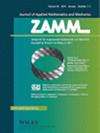Soret和Dufour影响下多孔介质中carau - yasuda混合对流的非相似模拟分析
IF 3.2
4区 工程技术
Q1 MATHEMATICS, APPLIED
Zamm-zeitschrift Fur Angewandte Mathematik Und Mechanik
Pub Date : 2023-09-04
DOI:10.1002/zamm.202100603
引用次数: 0
摘要
本文研究了carau - yasuda (CY)纳米流体模型在垂直可扩展表面上的非相似对流。对流在充满流体的可渗透介质中得到了应有的考虑,因为它与各种应用相关,包括绝缘、地热储层水的重新安置、核废料的储存、可再生能源、机械工程和提高油藏采收率。由于线性拉伸和浮力效应,固定流体沿垂直多孔表面流动。在x动量方程中,考虑了温度和浓度下的线性浮力。在存在Dufour和Soret影响的情况下,对能量表达式进行建模。通过适当的非相似变换,将描述对流方程的控制微分系统转化为非线性偏微分系统。利用解析局部非相似(LNS)技术和bvp4c(数值有限差分算法),对变换后的无量纲非相似结构进行了数值模拟。最后,研究了输运量如温度、浓度和速度场等重要无因次数的变化。给出了相关参数对阻力系数、努塞尔数和舍伍德数的影响。非相似模型的数值模拟表明,由于Weissenberg数、孔隙度和吸力参数的增大,速度剖面减小。与较高的估计、Eckert和Dufour数字相比,温度分布增加了。由于索雷特数和普朗特数较大,可见浓度分布增加。摩擦系数和努塞尔数分别随着孔隙度参数、Weissenberg数和Prandtl数的升高而增大,而随着Dufour和Eckert的变化而减小。本文章由计算机程序翻译,如有差异,请以英文原文为准。
Nonsimilar modeling analysis of Carreau–Yasuda mixed convective flow in a porous medium subjected to Soret and Dufour influences
This nonsimilar convection study is about the flow of Carreau–Yasuda (CY) nanofluid model above a vertically extendible surface. Convection in a fluid‐filled permeable medium has given due consideration because of its relevance in a variety of applications, including insulation, relocation of water from geothermal reservoirs, storage of nuclear waste, renewable energy, mechanical engineering, and enhanced oil reservoir recovery. By virtue of linear stretching and buoyancy effects, flow in a stationary fluid is induced along a vertical porous surface. In x‐momentum equation, linear buoyancy in the context of temperature and concentration is taken into consideration. Modeling of energy expression is done in the presence of Dufour and Soret influences. Governing differential system describing convection equations is changed into nonlinear partial differential system (PDE) by implementing applicable nonsimilar transformations. By making use of analytical local nonsimilarity (LNS) technique and bvp4c (numerical finite difference‐based algorithm), the transformed dimensionless nonsimilar structure is simulated numerically. At the end, the alteration of important nondimensional numbers is studied on transport quantities such as temperature, concentration and velocity field. The repercussions of relevant parameters on drag coefficient, Nusselt number and Sherwood number have been tabulated. Numerical simulations of nonsimilar model suggests that the velocity profile reduces due to rise in the values of Weissenberg number, porosity and suction parameter. The temperature profile is increased in comparison with the higher estimates, Eckert, and Dufour numbers. Because of larger values of Soret and Prandtl number, an increase in concentration profile is seen. Friction coefficient and Nusselt number increases with respect to higher estimations of porosity parameter, Weissenberg number and Prandtl number respectively, whereas they decrease against Dufour and Eckert variations.
求助全文
通过发布文献求助,成功后即可免费获取论文全文。
去求助
来源期刊
CiteScore
3.30
自引率
8.70%
发文量
199
审稿时长
3.0 months
期刊介绍:
ZAMM is one of the oldest journals in the field of applied mathematics and mechanics and is read by scientists all over the world. The aim and scope of ZAMM is the publication of new results and review articles and information on applied mathematics (mainly numerical mathematics and various applications of analysis, in particular numerical aspects of differential and integral equations), on the entire field of theoretical and applied mechanics (solid mechanics, fluid mechanics, thermodynamics). ZAMM is also open to essential contributions on mathematics in industrial applications.

 求助内容:
求助内容: 应助结果提醒方式:
应助结果提醒方式:


